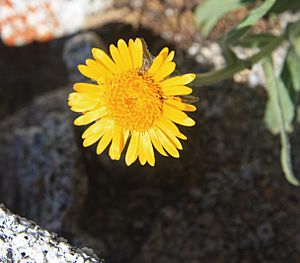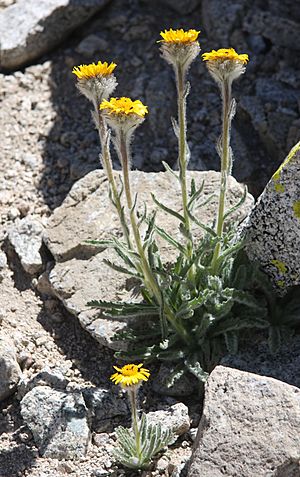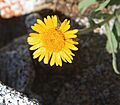Pacific hulsea facts for kids
Quick facts for kids Pacific hulsea |
|
|---|---|
 |
|
| Scientific classification | |
| Kingdom: | |
| (unranked): | |
| (unranked): | |
| (unranked): | |
| Order: | |
| Family: | |
| Genus: |
Hulsea
|
| Species: |
H. algida
|
| Binomial name | |
| Hulsea algida |
|
| Synonyms | |
|
|
Hulsea algida, also known as Pacific hulsea or alpine gold, is a type of flowering plant. It belongs to the daisy family, which includes many well-known flowers like sunflowers and dandelions.
This plant is found in several western US states. You can spot it in California, Oregon, Nevada, Idaho, Montana, and Wyoming. In California, it grows in the Sierra Nevada mountains and the White Mountains. It likes to grow in high places, usually between 9,500 and 14,000 feet (about 2,900 to 4,300 meters) above sea level. It thrives in alpine and subalpine areas, often in rocky, loose slopes called talus habitats.
What Does Alpine Gold Look Like?

Hulsea algida is a perennial herb. This means it's a plant without a woody stem that lives for more than two years. It has tiny hairs and glands (small structures that produce substances) all over it. Its strong, straight stems can grow up to 40 centimeters (about 16 inches) tall.
The leaves are dark green, narrow, and covered in white hairs. Their edges are wavy and have small teeth. Most of the leaves grow in a thick bunch at the bottom of the plant, but some also grow along the stems.
Its Unique Flowers
The plant's flower head looks like a single large flower, but it's actually a cluster of many tiny flowers grouped together. This type of flower head is called a pseudanthium. It's wrapped in a cup made of fuzzy, reddish-green leaf-like parts called phyllaries.
When the flower head opens, it shows a daisy-like bloom that is one to three centimeters (0.4 to 1.2 inches) wide. The center of the flower head is full of small yellow or orange disc florets. Around the edge, there are up to 60 bright yellow or gold ray florets. Each ray floret is about one centimeter (0.4 inches) long and has rounded or slightly toothed tips.
Seeds and Reproduction
After the flowers bloom, the plant produces a fruit called an achene. An achene is a small, dry, one-seeded fruit, like a sunflower seed. These achenes can be up to a centimeter long. Each achene has a special feathery or bristly structure called a pappus, which helps the seed float away in the wind, allowing the plant to spread its seeds.
Images for kids



